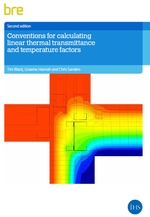Conventions for calculating linear thermal transmittance and temperature factors
BRE is an independent, research-based consultancy, testing and training organisation, operating in the built environment and associated industries.
On 3 June 2016, BRE published Conventions for calculating linear thermal transmittance and temperature factors (BR 497 2nd edition), written by Tim Ward, Graeme Hannah and Chris Sanders.
Well-insulated buildings require sophisticated techniques to model heat loss caused by thermal bridging at wall, roof and floor junctions and around openings. Thermal bridging at these junctions can add significantly to fabric heat loss and cause localised reduction in internal surface temperatures, which can lead to surface condensation and mould problems. A more detailed calculation method for U-values, as defined in BS EN ISO 6946:2007, has been introduced to take account of these repeating thermal bridges.
The BRE guide provides the information needed to carry out these calculations so that different users of the same software package or users of different software packages can obtain consistent and reproducible results. It is intended for use by designers and numerical modellers.
For building regulation purposes two key modelling outputs are identified:
These outputs enable designers to assess junction details and develop novel solutions to improve thermal performance.
The second edition of the guide has been updated to include additional junction types and information about how they should be modelled, as well as worked examples giving the determined values of linear thermal transmittance and temperature factors.
The contents of the guide are:
- Introduction.
- Numerical modelling.
- Thermal bridging at junctions.
- Junction types.
- Point thermal bridges, chi-values.
- Reporting of calculations.
- References.
- Appendix A: Detailed Input and Output from a numerical model.
- Appendix B: Worked examples with calculated values of psi and f.
[edit] Find out more
[edit] Related articles on Designing Buildings Wiki
- Air tightness in buildings.
- Cavity wall insulation.
- Computational fluid dynamics.
- Computational fluid dynamics in building design: An introduction FB 69.
- Conventions for U-value calculations (2006 edition) BR 443.
- Floor insulation.
- g-value.
- k-value.
- Heat transfer.
- Insulation specification.
- Limiting fabric parameters.
- Roof insulation.
- Solid wall insulation.
- Standard Assessment Procedure SAP.
- Thermal admittance.
- Thermal bridge.
- Thermal mass.
- Thermographic survey.
- U value.
- U-value conventions in practice: Worked examples using BR 443.
Featured articles and news
Delivering for tenants; National Retrofit Hub
New report offers recommendations to strengthen energy efficiency standards to protect private renters.
Government consultations for the summer of 2025
A year of Labour, past and present consultations on the environment, the built environment, training and tax.
CMA competitiveness probe of major housing developers
100 million affordable housing contributions committed with further consultation published.
Homes England supports Greencore Homes
42 new build affordable sustainable homes in Oxfordshire.
Zero carbon social housing: unlocking brownfield potential
Seven ZEDpod strategies for brownfield housing success.
CIOB report; a blueprint for SDGs and the built environment
Pairing the Sustainable Development Goals with projects.
Types, tests, standards and fires relating to external cladding
Brief descriptions with an extensive list of fires for review.
Latest Build UK Building Safety Regime explainer published
Key elements in one short, now updated document.
UKGBC launch the UK Climate Resilience Roadmap
First guidance of its kind on direct climate impacts for the built environment and how it can adapt.
CLC Health, Safety and Wellbeing Strategy 2025
Launched by the Minister for Industry to look at fatalities on site, improving mental health and other issues.
One of the most impressive Victorian architects. Book review.
Common Assessment Standard now with building safety
New CAS update now includes mandatory building safety questions.
RTPI leader to become new CIOB Chief Executive Officer
Dr Victoria Hills MRTPI, FICE to take over after Caroline Gumble’s departure.
Social and affordable housing, a long term plan for delivery
The “Delivering a Decade of Renewal for Social and Affordable Housing” strategy sets out future path.
A change to adoptive architecture
Effects of global weather warming on architectural detailing, material choice and human interaction.
The proposed publicly owned and backed subsidiary of Homes England, to facilitate new homes.
How big is the problem and what can we do to mitigate the effects?
Overheating guidance and tools for building designers
A number of cool guides to help with the heat.
The UK's Modern Industrial Strategy: A 10 year plan
Previous consultation criticism, current key elements and general support with some persisting reservations.
Building Safety Regulator reforms
New roles, new staff and a new fast track service pave the way for a single construction regulator.



























